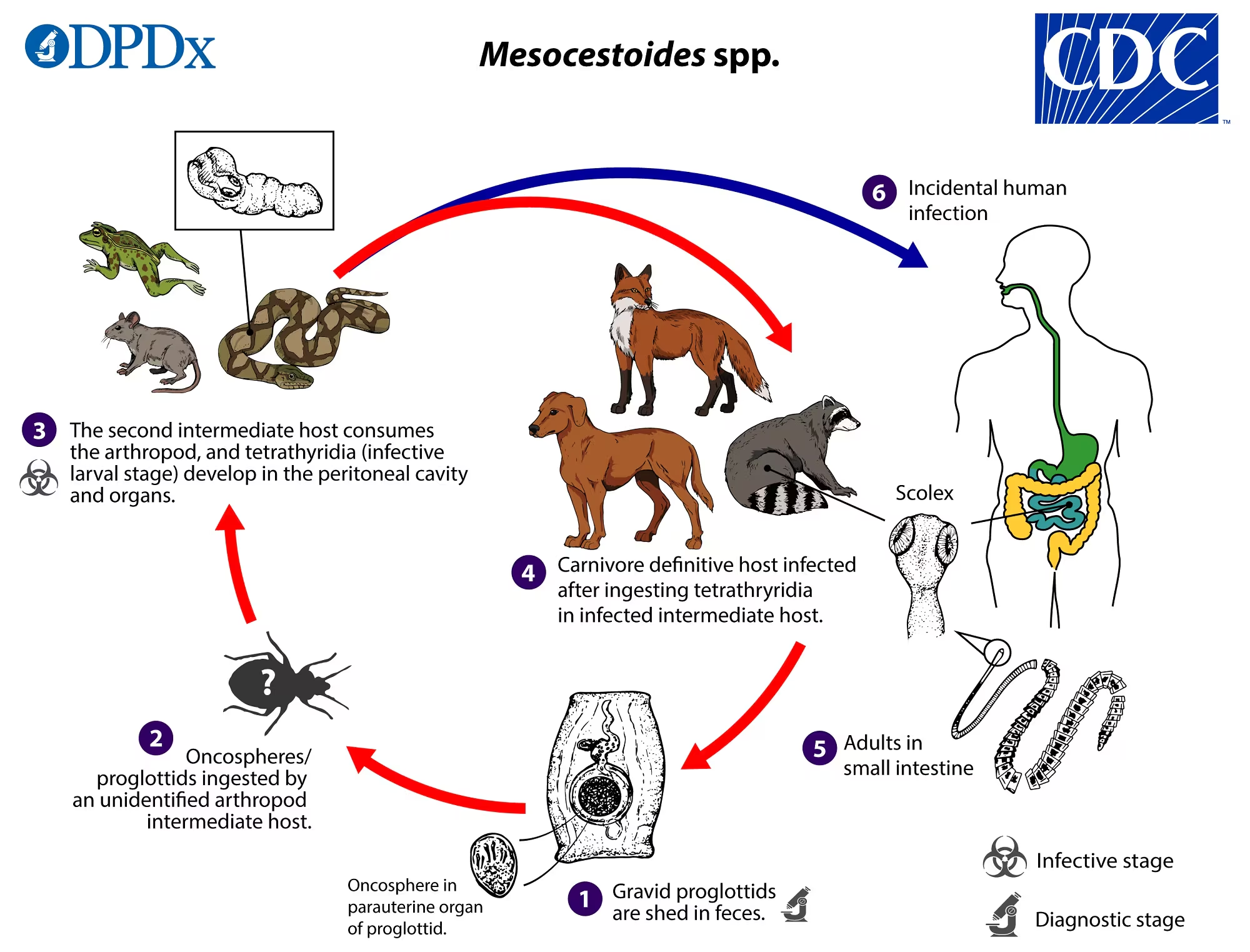Practical week 2: cestoda
1/34
Earn XP
Description and Tags
based on practical from moodle, and what was said in class (finished)
Name | Mastery | Learn | Test | Matching | Spaced |
|---|
No study sessions yet.
35 Terms
Cestoda is a class of?
A class of flatworms commonly known as tapeworms.
under phylum platyhelminthes
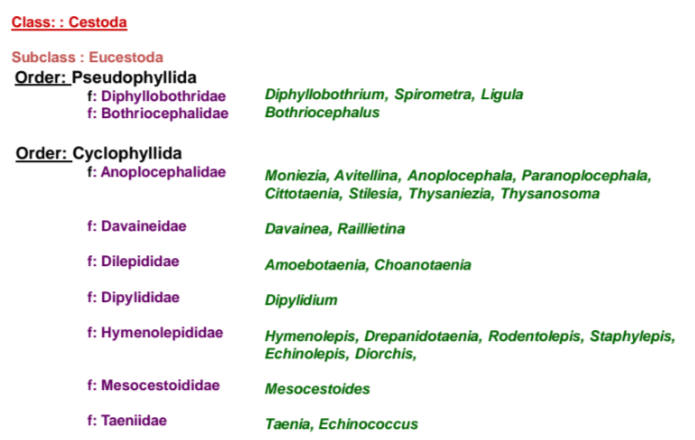
Trematoda is?
A subphylum of helminths that includes flukes. Has 2 classes, Aspidogastrea and Digenea
under phylum Platyhelminthes (flatworms)

The anatomy of class cestoda
body is covered by?
regions?
attachment organs?
Exclusively endoparasites
body is covered by a tegument (surface)
Regions of body: body consist of an anterior scolex, followed by short neck and then a strobila composed of a series of “segments” or proglottids.
Attachment organs: Bothria, sucker, rostellum, hooks
Digestive tract is absent
hermaphrodite
length mm-m.
shape: DV flattened
what are the 2 orders of cestoda? which one has rostelleum + hooks?
Pseudophyllidea: bothria (grooves) - 2 longitudinally arranged, shallow depressions for attachment.
Cyclophyllidea: has suckers (usually 4) and often a rostellum (hook bearing structure) for attachment on the head (scolex).
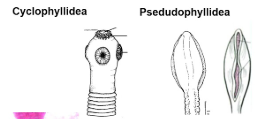
tapeworms live where in the body in most cases?
in 99% cases, they live in small intestine, but sometimes in other parts.
humans get contaminated by food - raw/undercooked meat (beef/pork)
Explain the systems of class cestoda. (AS, NS, ES, RS)
Absorptive system: lacks digestive system, food is absorbed through skin (tegument).
Nervous system: in the scolex (head) consisting of:
rostellar nerve ring (circular nerve structure around the rostelleum)
2 lat. nervous ganglia (nerve clusters)
Excretory system: nephridial system with flame cells (cells for osmoreg. + waste excretion) + efferent canals (sends waste out of body)
reproductive system: hermaphroditic, each individual has both male and female reproductive organs.
The unsegmented neck of class cestoda contains?
contains germinal cells responsible for budding off of new proglottids.
proglottids: segments of the tapeworm - each containing reproductive organs.
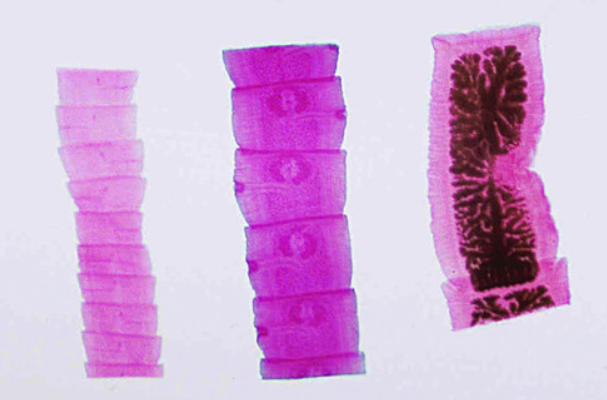
what are the types of proglotiids of class cestoda?
types of proglottiids - segments. (varies in number, 3-1000 + varies in shape).
immature: early stage, reproductive organs not fully developed.
mature: fully developed, can fertilize
gravid: filled with eggs, ready to be released.
1/3 female, 1/3 male, 1/3 female/male.
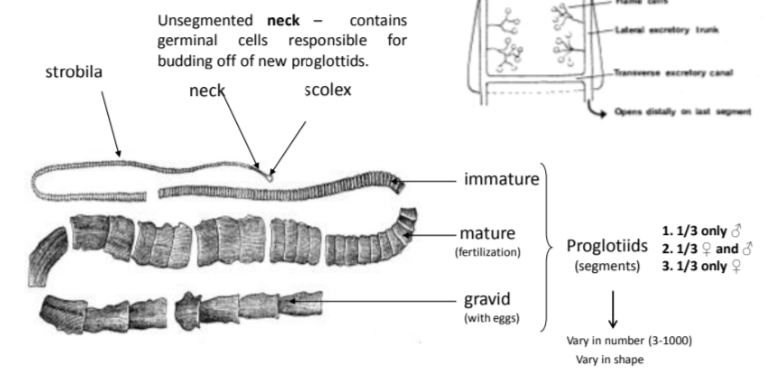
What is the strobila?
The chain of proglottids that make up the body of the tapeworm.
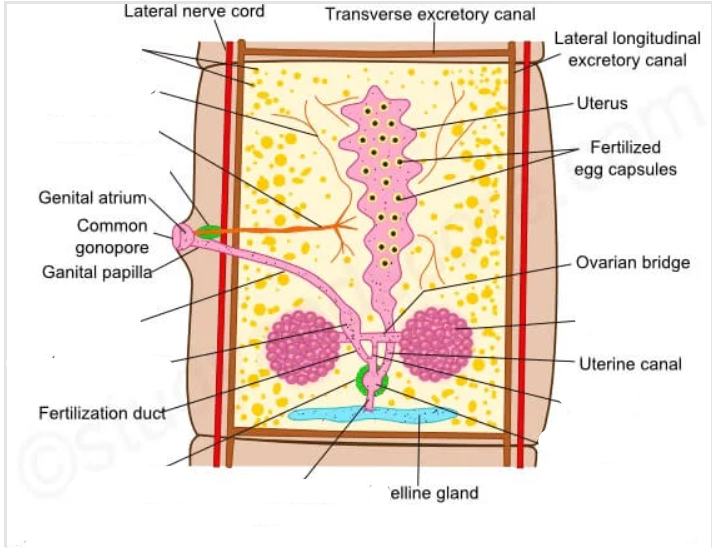
what are the reproductive organs we can see in class cestoda?
(picture - taenia solium)
female:
ovarium (can be lobed or unlobed)
oviductus
ootype - with structures inv. in shell formation
mehlis gland - surrounds ootype + sends into it material needed for making eggshell
vitelline duct (scattered)
seminal vesicle - receptaculum seminis (storage of sperms)
male:
testes - alot
vas efferens + deferens
cirrus sac, cirrus
prostate glands
genital pore - only one with one set, while 2 pores in double set of reproductive organs.

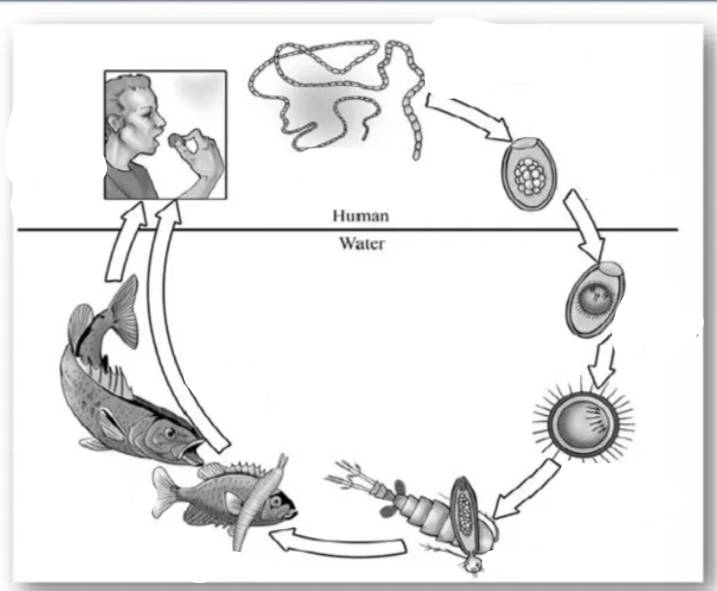
This is the life cycle of?
Life cycle of: genus: DIPHYLLOBOTHRIUM LATUM (species). - fish tapeworm. (zoonosis)
class: cestoda, order: Pseudophyllidea (bothria - grooves instead of suckers on head, has 2 IH), family: diphyllobothridae.
Life Cycle Stages:
Eggs in Water:
Adult tapeworms in the human small intestine release eggs, which are passed out in the feces.
These eggs are non-infective to humans at this stage.
Development in Water:
The eggs hatch in freshwater, releasing free-swimming larvae called coracidia.
First Intermediate Host (Copepods):
The coracidia are ingested by copepods (small aquatic crustaceans).
Inside the copepod, the larvae develop into the next stage, called procercoid larvae.
Second Intermediate Host (Fish):
Infected copepods are eaten by freshwater fish.
In the fish, the procercoid larvae migrate to the muscles and develop into plerocercoid larvae, which are infective to humans.
Definitive Host (Humans or Mammals):
Humans become infected by consuming raw or undercooked fish containing plerocercoid larvae.
In the human intestine, the larvae attach to the intestinal wall and develop into adult tapeworms.
The adult tapeworms can grow up to 10 meters in length and release eggs, completing the cycle.
Key Points:
Intermediate Hosts: Copepods (first) and freshwater fish (second).
Definitive Host: Humans or other fish-eating mammals (e.g., bears, dogs, cats).
Infection Route: Consumption of raw or undercooked infected fish.
Disease: The infection is called diphyllobothriasis, which can cause vitamin B12 deficiency and anemia in severe cases.
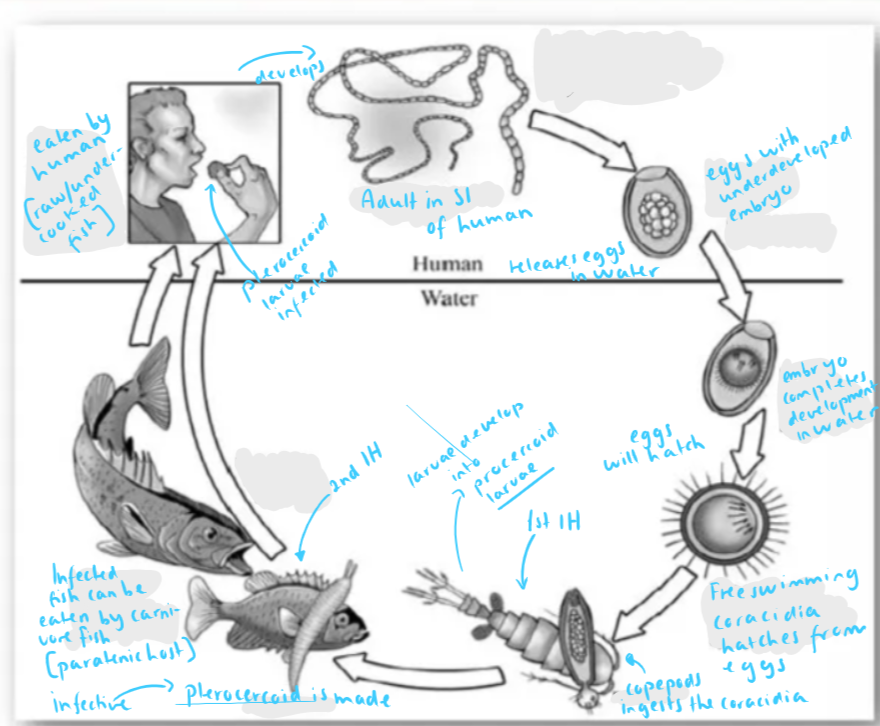

The main stages of pseudophyllidea?
eggs released → coracidium (larva has ciliated epithelium)
procercoid (elongated structure with 6 hooks at posterior end)
at 1st IH (aquatic arthropod)
plerocercoid (worm like, invaginated scolex at one end)
at 2nd IH (fish - muscle)
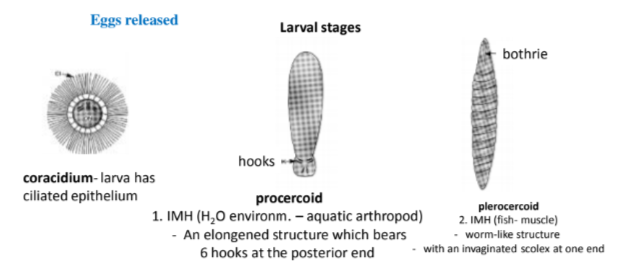

Cyclophyllidea - larva from egg are called? and develops into?
oncosphere or hexacanth embryo - larva that hatches from the egg, it actively penetrates the GIT or the IH and develops into metacestodes.
we describe:
shape: spherical/oval
size: small
shell: thick, shell - often striated (has fine lines/ridges)
content: has a hexacanth embryo (oncosphere) - with 6 hooklets for attachment.
color: brownish/yellowish
embryonated and infective when passed in the feces of the final host
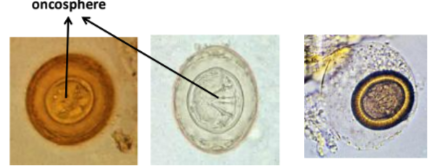
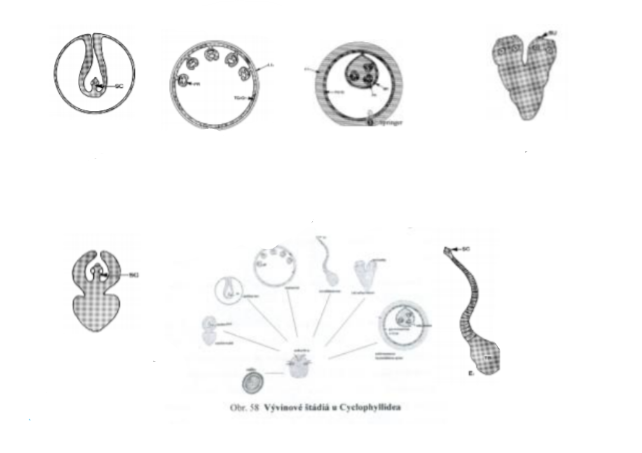
Name the larval stages - metacestodes.
Cysticercus:
A single scolex invaginated into itself within a large fluid-containing vesicle or bladder (e.g., Taeniidae).
Cysticercoid:
A single non-invaginated scolex drawn into a small vesicle with practically no cavity (e.g., Dipylidium caninum, Moniezia, Anoplocephala).
Coenurus:
A large fluid-containing bladder with multiple invaginated scolices attached to the wall (e.g., Taenia multiceps).
Echinococcus:
A large fluid-filled structure that produces multiple infective stages (protoscolices – invaginated scolices containing suckers and hooks).
Tetrathyridium:
An elongate, solid-bodied metacestode with a deeply invaginated scolex.
Strobilocercus:
A single scolex, which is not invaginated when fully developed, attached to the bladder by a long, segmented strobila (e.g., Taenia taeniaformis).
Additional Notes:
These larval stages represent the intermediate developmental forms of Cyclophyllidea tapeworms.
The term "metacestode" refers to the larval stage of tapeworms, which develops in the intermediate host.
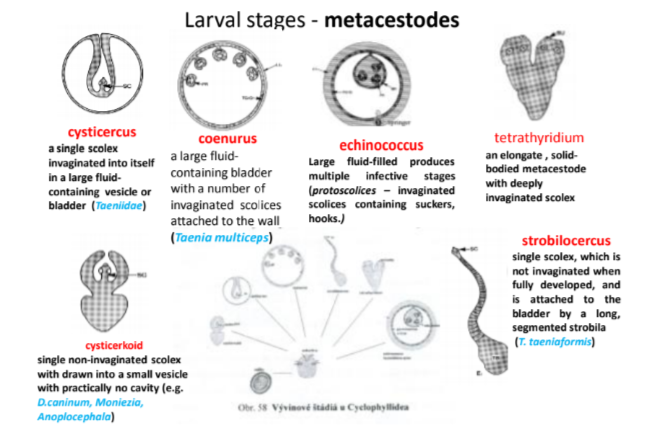
what family does genus moniezia belong to?
family: Anoplocephelaidae
Moniezia expansa
Moniezia benedeni
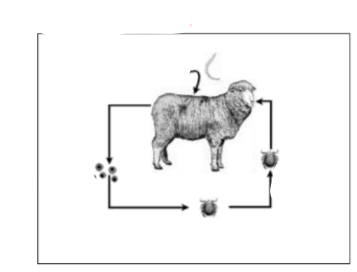
what are the key stages in this life cycle? which parasite is this of?
Moniezia of family anoplocephalidae.
worm matures in the small intestine
eggs are shed in feces
eggs are ingested by oribatid mites → oncosphere
sheep eat infected mites (body cavity)
cysticercoid develops in the small intestine of ruminants
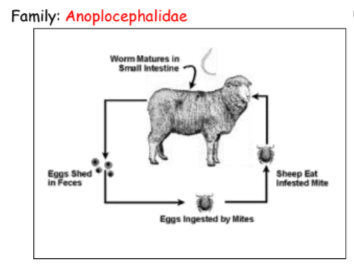
characterize Moniezia Expansa
hosts: sheep, goat, cattle (SI)
length: 6-10m
scolex (head): 4 suckers
reproductive organs: double
interproglottidal glands
eggs: polyhedral with pyriform apparatus (pear-shape), 50-75 um.
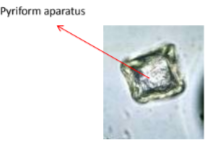
characterize Moniezia benedeni
hosts: cattle + older sheep
length: 4m
scolex: 4 suckers
eggs: polyhedral with pyriform apparatus, 80-85 um.
The intermediate host for Moniezia are?
oribatid mites (oribatidae)
the larval stage of moniezia developing in the body cavity of oribatid mites is called?
cysticercoid
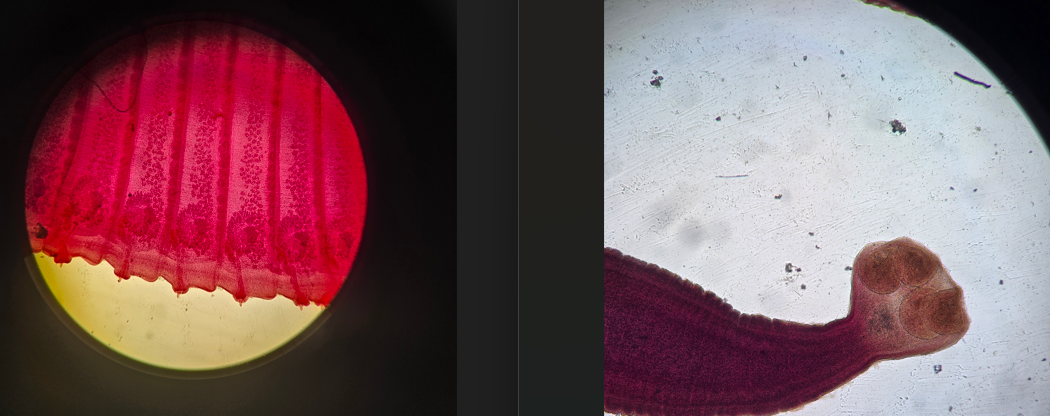
identify these.
left: m. expansa
wide band, extending across most of proglottid
excretory canal, ovary, interproglottidal glands at sides
right: m. benedeni
interproglottidal glands at the sides
narrow band linear in appearance
ovary, yolk glands, vagina, cirrus sac
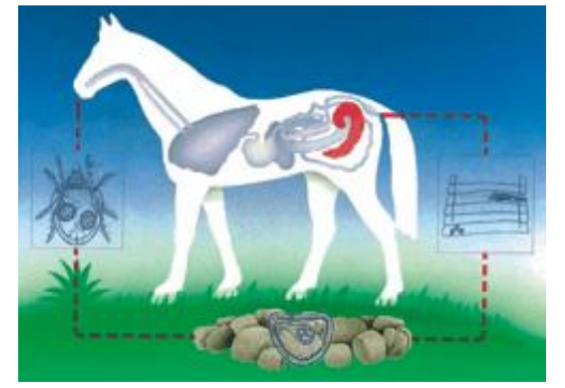
there are 3 tapeworms which particularly infect horses. (family. anoplocephalidae), which ones?
anoplecaphala magna - SI, 80cm
can cause intestinal obstruction/damage due to large size
anoplocephala perfoliata - si + HC, 20cm
MOST PATHOGENIC, often linked to colic, ileocecal valve dysfunction + inflammation
paranoplocephala mamillana - stomach + SI (5cm)
mild GIT issues
Has 4 suckers, 4 lappets - aurikula
single reprod. organ
IH: orbatid mites - cysticercoid.
Proglottids are wider than they are long.

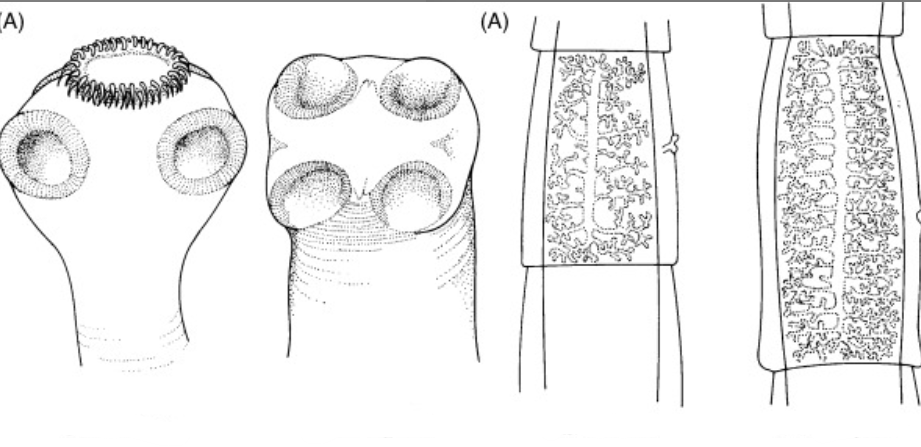
Identify the two different species.
taenia solium (pork tapeworm)
has rostelleum with 2 rows of hooks
2-3m
800-1000 segments
IH: pigs
FH: humans
causes cysticercosis in humans
taenia saginata (beef tapeworm)
NO rostelleum or hooklets
5-10m
1000-2000 segments
IH: cattle
FH: humans
less pathogenic
both species belong to genus Taenia, part of phylum platyhelminthes (flatworms). Family: Taenidaee.
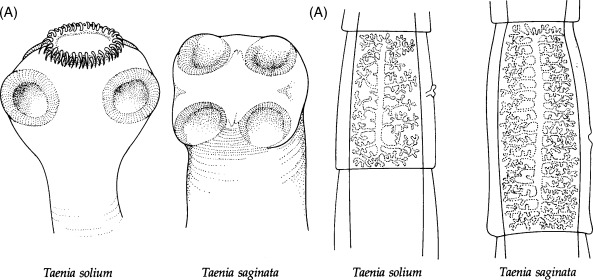
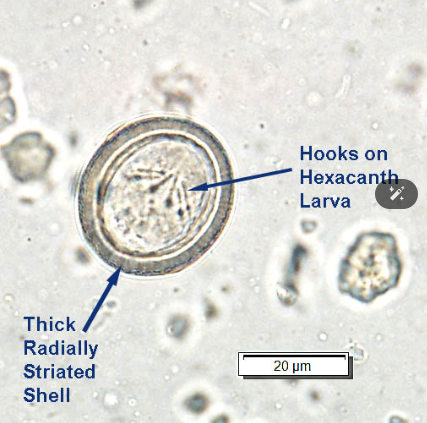
describe the egg of taenia solium + taenia saginata.
eggs of taenia species - industinguishable.
shape: round/oval
size: 30-35 um in dm, small
shell: thick, striated shell
contains: hexacanth larva with 6 hooks, not all are visible in each egg.
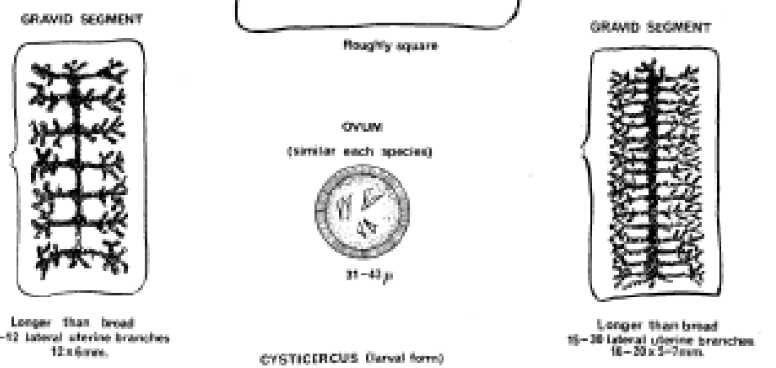
identify.
gravid segment
taenia solium
taenia saginata

this life cycle belong to?
belongs to taenia saginata and taenia solium.
same principle:
eggs released by human feces
enters IH (cattle or pig)
oncospheres are released here from the eggs → goes to muscles
in muscle: develops into cystercerci
FH: human, eats the infected meat (undercooked)
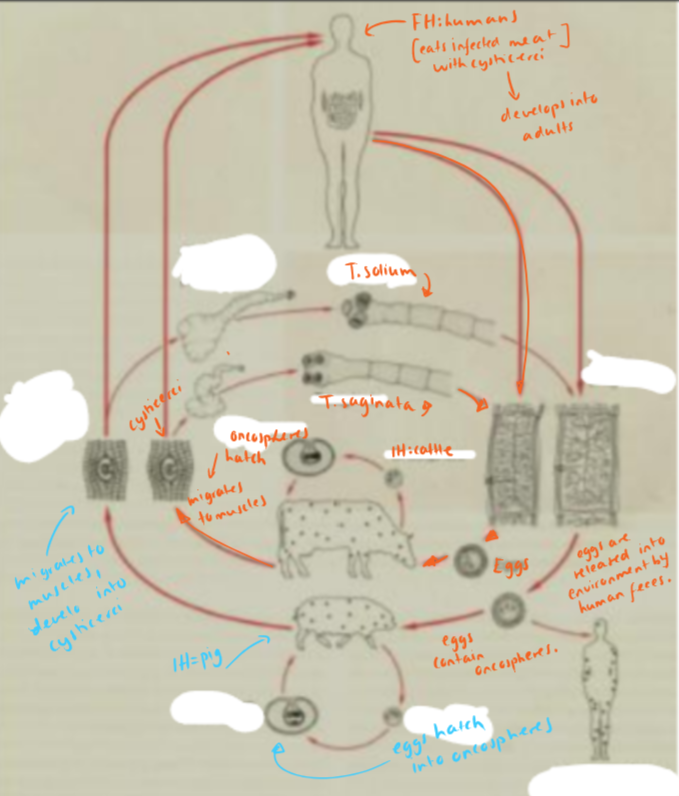
Taenia solium vs. taenia saginata?
T. saginata:
Cysticercus bovis infectivity about 10 weeks)
cystercery in muscle, heart, diaphragm, tongue, limbs
4 suckers, WITHOUT rosteleum
IH: big ru
proglottids longer than broad
proglottids are shed into environment either during defecation or independently after their active migration through anus
lateral uterine branches 15-30
length: 10m-15m
T. solium:
C. cellulosae, C. racemosus
4 pris, rostelum with hooks!
IH: swine
proglottids longer than broad
lateral uterine branches 7-12 (gravid proglottids)
2-3m
less than 1000 proglottids
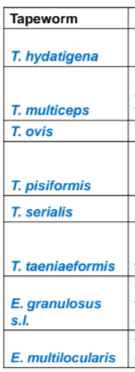
link to DH, larval stage, IH, localization

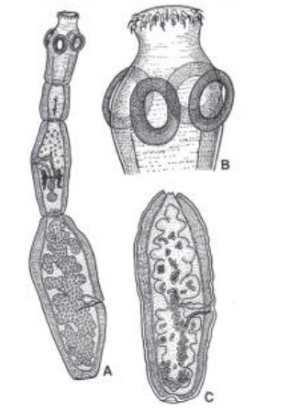
family taeniidae, genus echinococcus typical?
carnivorous animal, that exploit predator - prey systems
small 2-7mm
3-5 proglottids
suckers, rosteleum, hooks
each segment has a single genital pore
terminal proglottid measuring less than half the length of the whole worm
echinococcus granulosus s.I. and echinococcus multilocularis
IH?
the smallest tapeworm 2-8mm
scolex rostellum with double row hooks, 4 suckers
strobila consists 3-4 proglottids
DH: car, fel, inhabit SI
IH of echinococcus granulosus: sheep, cattle, pigs, goat, human, camel, deer
IH of echinococcus multilocularis: human, moles, mice, gerbils, rats, squirrels
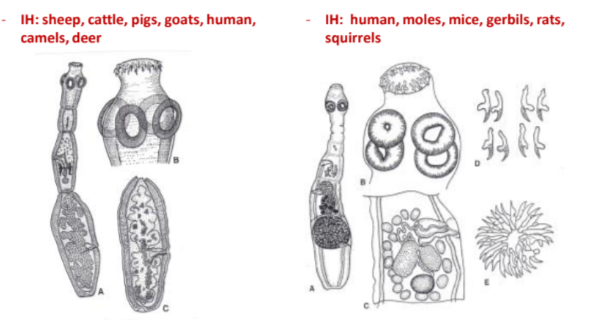
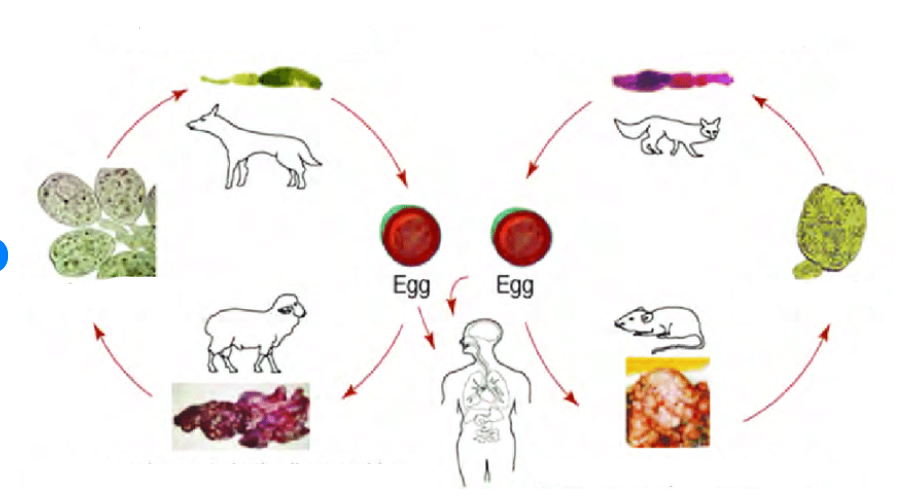
These life cycles belong to?
two species of tapeworms that cause hydatid disease in humans and animals.
Life Cycle of Echinococcus granulosus → hyatidosis
Eggs:
Eggs are released into the environment through the feces of the FH ex. dog
These eggs contain oncospheres, the infective stage.
Intermediate Host (Sheep, Cattle, Humans):
ingest the eggs from contaminated food, water, or soil.
In the intestine, the eggs hatch into oncospheres → liver or lungs.
develops into unilocular hyatid cysts with protoscoleces (larval forms)
Definitive Host (Dogs or Canines)
In the dog’s intestine, the protoscoleces develop into adult tapeworms, completing the cycle.
Life Cycle of Echinococcus multilocularis → alveococcis
location: liver, lung, heart, brain, bone marrow, muscle, lymph nodes. DH: fox, dog, wild canids, racoon, cat. IH: rodents + human.
Eggs:
Similar to E. granulosus, eggs are released into the environment through the feces of the definitive host (usually foxes or other wild canines).
Eggs contain oncospheres.
Intermediate Host (Rodents, Humans):
ingest the eggs from contaminated food, water, or soil.
In the intestine, the eggs hatch into oncospheres → liver.
In the liver, they develop into multilocular cysts, which grow in a tumor-like manner and contain protoscoleces.
also Alveolar cysts
Definitive Host (Foxes or Wild Canines):
In the intestine, the protoscoleces develop into adult tapeworms, completing the cycle.
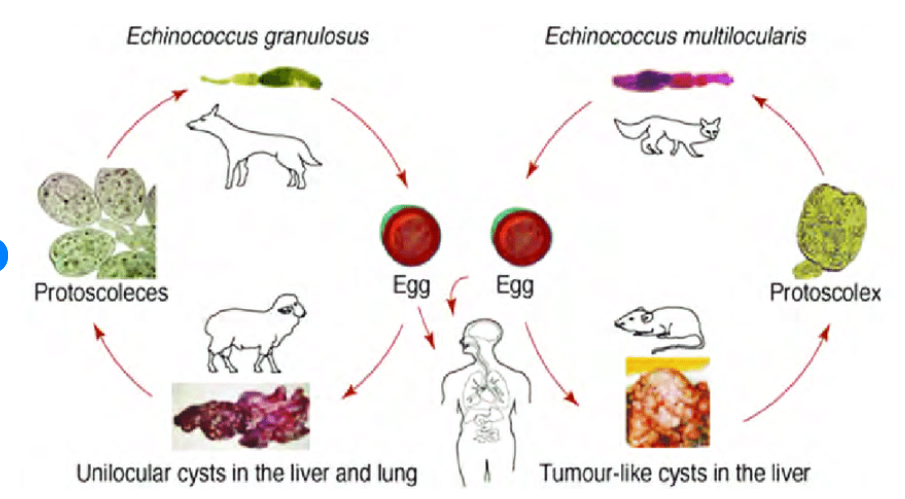
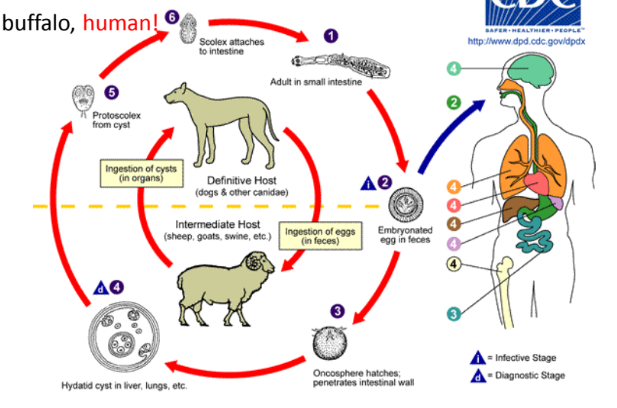
this is life cycle of?
Echinnococcus granulosus
produces multiple infective stages (protoscolices) → direclty from GL of cycst or by forming sacs with protoscolices by endogenous budding of the germinal layer
DH: dog, fox, wild canids
IH: sheep, cattle, camel, pig, human
location: mainly liver, lung
strobila: 3 proglottids
rostelum + hooks
Explain the characteristics of dipylidium caninum.
FH?
IH?
Metacestode stage?
FH: dog, cat, wild canids, fox, human (zoonosis)
location: SI, 20-50cm, 4 suckers, 3-4 rows of hooks
each paraglottid has two sets of genital organs with genital pore on each lateral edge.
eggs are made + enclosed in capsules with up to 25 eggs.
IH. FLEAS, LOUSE
metacestode stage: Cysticerkoid
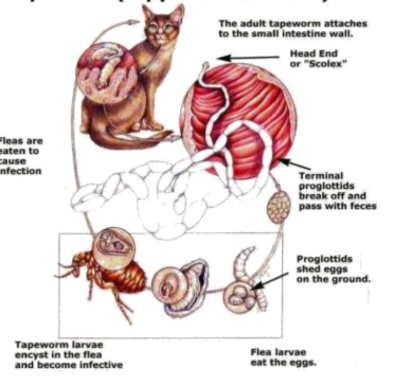
this is the life cycle of?
dipylidium caninum.
Important: IH - FLEAS, FH - CAT/DOG
adult - in FH (dog/cat)
adult tapeworm attaches to SI using its scolex (head) which has hooks and suckers.
It grows by making segments (proglottids) → mature + breaks off from main body.
shedding of proglottids + eggs
terminal proglottids (mature segments) → breaks off + passed in host feces
these proglottids contain eggs → released into environment.
IH: Fleas ingest the eggs
inside flea larvae → egg develop into cysticercoids (infective larvae)
as flea larvae mature into adult fleas → cysticercoids become infective.
Infection of FH: dog/cat, becomes infected by ingesting the flea (can be during grooming/scratching).
inside FH: larvae is released from flea → adult tapeworms in intestine.
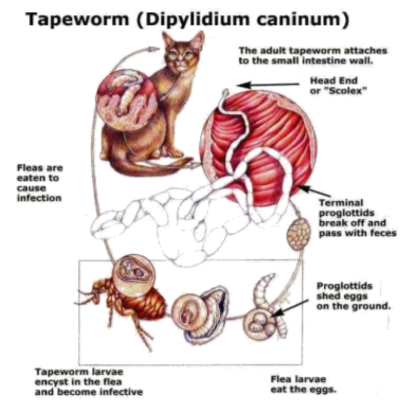
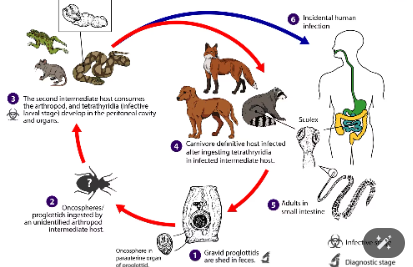
species of tapeworms in the family mesocestoididae?
mesocestoides lineatus
strobila (body length) - 30-80cm
FH: dog, cat, wild canids, human (rare)
Mesocestoides litteratus
FH: fox in europe
Characteristics:
scolex: both have scolex with 4 suckers
they have no rostellum or hooks
gravid proglottids (mature segments) - contain parauterine organ, which holds masses of eggs.
LIFE CYCLE:
1st IH: oribatid mites, beetles → cysticercoid
2nd IH: small mammals, reptiles, amphibians, lizards, birds → tetrahyridium (2-7cm)
